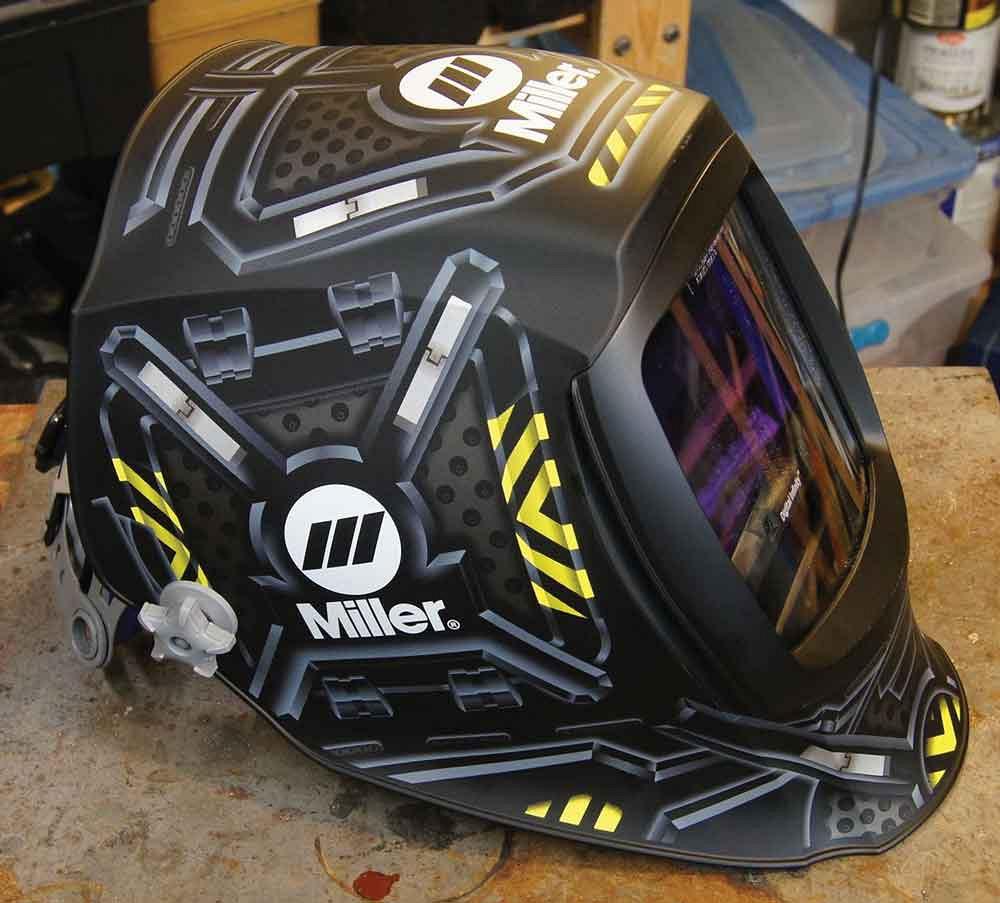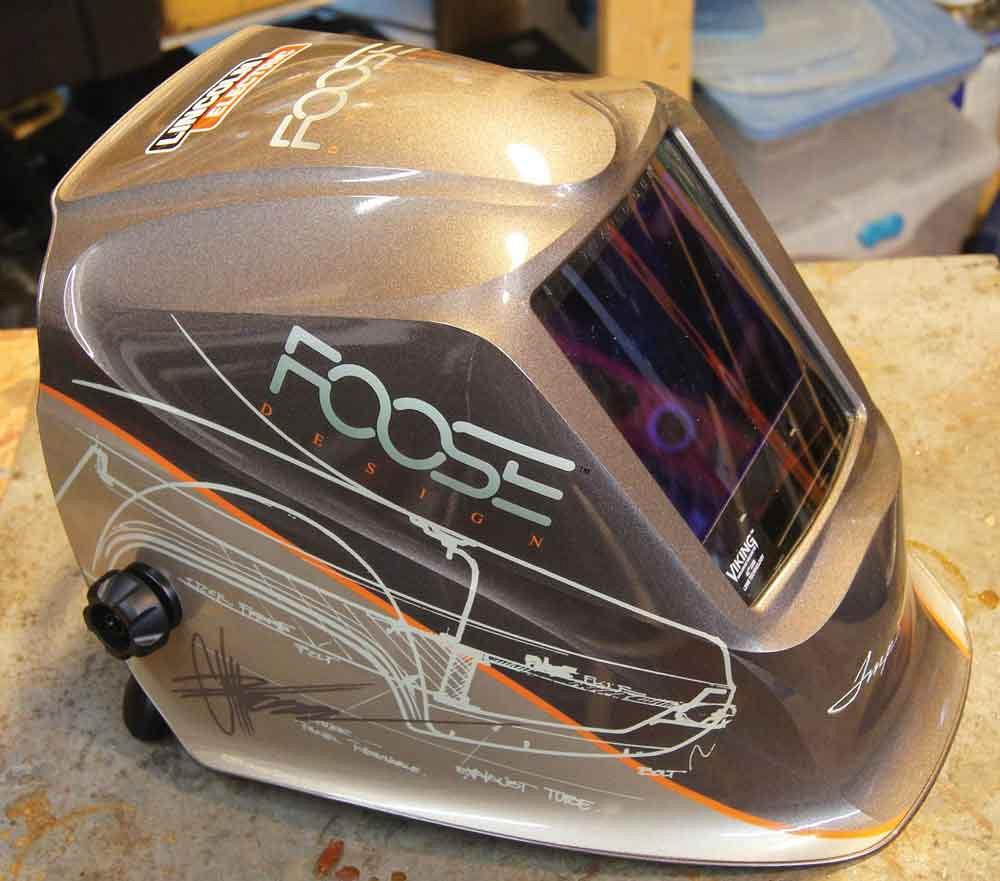- FMA
- The Fabricator
- FABTECH
- Canadian Metalworking
Welding Tech: What's on your head?
A welding helmet is the most important piece of safety equipment. It is hard to imagine anyone trying to weld without one, and it’s remarkable to see how much helmet technology has changed over the past few years
- By Nestor Gula
- August 24, 2016
A welding helmet is the most important piece of safety equipment. It is hard to imagine anyone trying to weld without one, and it’s remarkable to see how much helmet technology has changed over the past few years.
When I started welding, I was lucky that auto-darkening helmets were just being introduced to the marketplace. They were expensive, but I was able to snag one and have been using it for over a decade.
That helmet still works well, but I occasionally cast a loving eye at the new ones at FABTECH® or welding supply stores. The new helmets are usually lighter than my old one, the viewing area is bigger, and they are more comfortable to wear. With the motto “If it works, why replace it” ringing in my ears, I set out to find out if the newer breed of autodarkening helmets are that much more advanced than the one I have.
I was able to examine three helmets, one each from ESAB, Lincoln Electric, and Miller Electric. I quickly saw what a difference a few years makes.
Comfort
The first thing you will notice when donning a new helmet is the comfort. My old helmet is OK, but these three are in a different league.
“If you look at the new headgear compared with older ones, you have two straps across the top and enhanced back adjustment, the comfort pad,” said Eric Sommers, product manager for Miller Electric. “Our customers are wearing these eight hours a day, so outside of gloves or jackets, it’s one of the items of PPE [personal protection equipment] that the welder has on the most.”
The helmet they sent, the Digital Infinity™, Black Ops™ helmet, has an effective headgear system that makes it comfortable to have on for extended periods of time, even though it is heavier than my old helmet.
The Aristo® Tech HD helmet from ESAB is very light, which makes it sit comfortably on one’s head.
“Ergonomics and design have also hugely advanced over the last 10 years, with more thought going into the shell designs,” said Guy Shelverton, global product manager – welding PPE, for ESAB. “Headgears have improved, advancing in ergonomic comfort and more adjustability for the welder.”
Autodarkening Technology
A few years back I picked up an old-school, fixed-shade helmet when a friend was throwing it out. I’ve tried welding with this helmet a few times and quickly go back to my autodarkening helmet after experiencing sheer frustration.
“Over the past 10 years there have been major technological advances to welding helmets. Previously many operators used a passive lens with a fixed shade. These helmets illuminated the welding arc once it was initiated. Today the industry has primarily transitioned to autodarkening welding helmets, which automatically change shade when an arc is detected,” said Chase Rutti, product management – welding gear, for The Lincoln Electric Company. “Additional improvements such as variable shade control, sensitivity control, and grind mode are other prominent features in today’s market.”
The new lenses on welding helmets are huge, much bigger than the small viewing slits on my older helmets that are more akin to periscopes on a battle tank. Helmet manufacturers offer various sizes, but they all have one thing that my older helmets do not – peripheral vision. You can see the whole workpiece. Also, the glass is much brighter when not in weld mode so you can see the workpiece and what you are to weld much better than with the older helmets.
The Lincoln Electric VIKING™ 3350 Foose Impostor™ helmet has a huge 3.74- by 3.34-in. (95- by 85-mm) viewing area, and it is bright and clear. I can wear the helmet and type this article with no problems. I can actually do that with any of the helmets; they go dark only when I swivel my head toward a halogen desk lamp.
“The biggest evolution has been in the LCD technology used in the automatic darkening filter (ADF). Ten years ago, high optical class was difficult to achieve. Now we see a higher optical class available to many different manufacturers globally,” said Shelverton. “Manufacturing of such LCDs has become more cost effective; similar to the TV industry, we see higher definition for lower cost as technology improves. The main advantage this brings to the welder is the more he can see, the better the work standard, and less fatigue to the user’s eyes.”
Autodarkening helmets contain sensors that trip the lens element to go dark very quickly.
“Autodarkening elements contain several arc sensors which darken the filter when the light from a welding arc is detected. The current technology allows this process to occur at 1/25,000 second,” said Rutti.
The lens is basically a liquid crystal similar to a digital watch. There are two basic ways that the lens is triggered to go dark: optical and magnetic.
“The industry standard and the most widespread sensor is the optical sensor. It picks up on the light coming off of the weld. It triggers the layers, the LCD, to go dark,” said Sommers. “The magnetic sensing is great if you are outside, because autodarkening lenses with an optical sensor will be triggered to go dark from sunlight. A lot of times you don’t want your lens to go dark until you start welding. The magnetic sensor will avoid that and will also allow the lens to stay dark if you block all the sensors. If you are welding between some pipes, let’s say, and your sensors get blocked, the lens could potentially open up.”
Feature Upgrades
All current welding helmets let you adjust the shade, but some are loaded with features that are quite impressive. The Miller Infinity has a digital display that has a clock, an alarm, and a timer in the display, and it can track your arc time.
“Our lenses in the Infinity and the Titanium™ series have InfoTrac™ in the lens, and that will keep track of your arc time. That is a proprietary feature in Miller helmets that keeps track of the amount of arc time you are using,” said Sommers.
These features are added because some industrial manufacturing facilities do not allow watches, jewellery, or cell phones on the floor for safety reasons.
“We have gotten requests to incorporate a phone, but a lot of industrial applications don’t allow phones on the floor,” Sommers continued. “It is always a trade-off and balance between some really neat features that would be creature comforts for the welders and the kind manufacturers are comfortable with. It is what eliminates distractions and increases productivity.”
Maintenance Improvements
Because of the increase in lens size, it is inevitable that the helmets are generally heavier, but they are much more comfortable. They are also easier to maintain; there is not much to their maintenance except occasionally replacing the protective shield, which is easy on all these helmets.
“In general, autodarkening elements will need to have their batteries replaced periodically to remain operational. In some cases, the entire element may need to be swapped out if the cartridge malfunctions or is damaged. Some autodarkening helmets include a test mode, which fluctuates the ADF from light to dark, allowing the users to see if the helmet is functioning properly,” said Rutti. “In general, we recommend replacing your autodarkening welding helmet every three to five years since it is personal protective equipment. We hold safety to the highest standard and want to make sure all operators are properly protected when welding. If your helmet is 10 years old, chances are you’ll see the benefit in a new one, both from a comfort and functionality standpoint.”
A helmet that has been taken care of and not banged about will last a long time.
“If it has been looked after (i.e., not dropped or thrown around) and the batteries (if they can be) have been replaced regularly, then there is no reason why a 10-year-old helmet would not function,” said Shelverton. “It is possible to keep a helmet for this amount of time, although unlikely these days, as the cost of helmets has been reduced over the years, so people tend to buy new ones.”
Since sensitive electronics are built into the helmets, it is important not to subject them to too much abuse.
“With all electronics, there eventually might be failures,” said Sommers. “The LCD, the part that actually darkens, will not wear out after so many cycles. If you scratch or deteriorate the outside filter – the purple or blue coating on the lens which also helps to filter out light and arc rays as well – that would be a time to replace the lens.”
Safety First
A welding helmet is as crucial to a welder as the welding power source itself. The helmet must be functional and keep the operator safe.
“The forefront of all development is making sure that the helmet is protecting the welder, providing them with the proper coverage that is needed so they don’t get arc rays underneath,” said Sommers. “Also part of making them safe is making them comfortable, because if they are comfortable, they are going to keep the helmets on longer and most likely be better protected from other hazards in their weld cells. A lot of welders do just as much, if not more, grinding throughout the day. To have a multifunction helmet that has a grind mode is definitely a bonus because they are keeping the helmets on - keeping their helmets on and being protected.”
The three helmets that I have been working with are all different in terms of their features. One welder will appreciate the high-tech, feature-heavy digital display of the Miller Infinity helmets, while others will prefer the simple, no-fuss dials of the Lincoln Electric VIKING 3350 helmet. Still others will go for ESAB’s simple digital controls. But as helmets are a protective device, the features should only enhance the safety element of the helmet’s design.
“When designing a welding helmet, it is important to have good-quality optics to ensure the helmet performs well and has good reliability,” said Shelverton. “However, the most important part is making the helmet lightweight and balanced. A lot of welders suffer from neck ache when welding for long periods of time. Compared to a passive fixed-shade helmet, the automatic helmets carry a lot more weight, averaging between 450 g up to 800 g in some cases. This is due to the LCD glass inside the ADF and the power source needed to power it, usually in the form of two button lithium-ion replaceable batteries.”
Whichever type of helmet you decide to invest in, ensure that it is something you will feel comfortable in all day. Safety is paramount.
Nestor Gula is a Toronto, Ont.-based freelance writer. He can be reached at nestor.gula@yahoo.ca.
ESAB Welding & Cutting Products, 877-935-3226, www.esab.ca
Miller Electric Manufacturing Co., 920-734-9821, www.millerwelds.com
Lincoln Electric Canada, 416-421-2600, www.lincolnelectric.ca
subscribe now


Keep up to date with the latest news, events, and technology for all things metal from our pair of monthly magazines written specifically for Canadian manufacturers!
Start Your Free SubscriptionAbout the Author
- Trending Articles
BlueForge Alliance partners with Nuts, Bolts & Thingamajigs to develop Submarine Manufacturing Camps

Portable system becomes hot tech in heat treatment

Orbital tube welding webinar to be held April 23

Cidan Machinery Metal Expo 2024 to be held in Georgia May 1-2

Corrosion-inhibiting coating can be peeled off after use

- Industry Events
MME Winnipeg
- April 30, 2024
- Winnipeg, ON Canada
CTMA Economic Uncertainty: Helping You Navigate Windsor Seminar
- April 30, 2024
- Windsor, ON Canada
CTMA Economic Uncertainty: Helping You Navigate Kitchener Seminar
- May 2, 2024
- Kitchener, ON Canada
Automate 2024
- May 6 - 9, 2024
- Chicago, IL
ANCA Open House
- May 7 - 8, 2024
- Wixom, MI





















